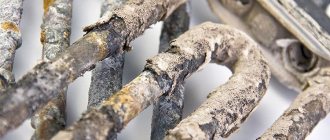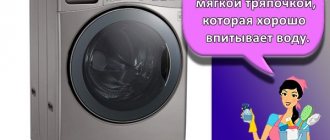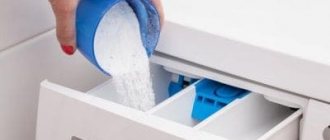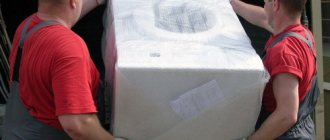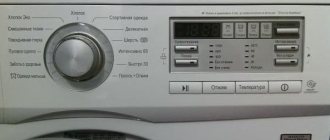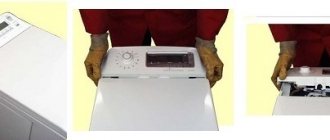Few people think about the question of how much powder to pour into the washing machine, but in vain. If you incorrectly calculate the volume of product, you can end up not only with dirty laundry, but also with a damaged washing machine. There are a number of aspects that need to be taken into account when calculating detergent.
- How much washing powder to use
- Amount of powder per cycle
- Hardness of water
- Degree of pollution
- Number of items loaded into the drum
- Water consumption per cycle
- Liquid proportions
How much washing powder to use
As a rule, information about the amount of household detergent is indicated on its packaging. This data can be relied upon in some cases, but a standard wash requires much less powder. The reason why manufacturers provide incorrect data is simple - any business is interested in increasing sales.
Expert opinion
Irina. Housewife.
Ask a Question
In this way, popular brands not only help themselves, but also provide a huge service to the creators of household appliances. After all, excess detergent can harm the washing machine.
Determining the amount of powder for washing
Excess washing powder leads to the following consequences:
- blurry white marks on clothes, this looks especially unpleasant on dark fabrics;
- Detergent compartment is broken. During washing, not all the powder is washed out of the tray, which leads to sticking of wet substances, rust and mold;
- unpleasant chemical smell from the machine or laundry;
- drain filter clogged.
Are you unplugging your washing machine?
Oh yes! No
In order to extend the life of your washing machine, you need to adhere to the following general rules:
- To determine the maximum filling level of the tray, you need to pay attention to its markings. You need to understand that it does not take into account the degree of workload and the quality of the water, so the markings can only serve as a guide for determining the maximum detergent.
- When choosing a new powder, you should pay attention to how it is used. Hand wash detergent contains a higher proportion of substances that promote the formation of abundant foam. This feature negatively affects machine washability. The fact is that excess foam can settle on the working parts of the equipment, accelerating its wear.
- You should pay attention to the composition of the detergent. Ingredients such as chlorine and solvents must be avoided as they have a negative effect on the rubber elements of the SMA.
Pour washing powder into the tray
Selecting a detergent
Excessive excess of the required volume of detergent can cause the appearance of incompletely dissolved crystals of the powder being poured on clothes. Or soap stains on fabrics, which is especially important for synthetics. Chemical compounds in the powder remaining after washing have a negative impact on human health. For allergy sufferers, this can cause a lot of trouble.
In addition, unspent powder can remain in the tray, forming a persistent coating, or clog the drain filter. Which inevitably leads to breakdowns of household appliances in the future.
Excessive savings can have the opposite effect - poorly washed laundry and unpleasant odors on it.
Rational use of a cleaning product would not only allow you to get high-quality washed laundry and save money on its purchase, but also significantly increase the life of the washing machine.
steam treatment
Today, based on personal convenience and desires, we can purchase the product not only in powder form, but also in gel, capsules or tablets. In this case, the proportions will be slightly different. If everything is clear with tablets and capsules - one wash, one tablet - then with concentrated gel not everything is so clear.
If you rely only on the information plate on the packaging, then you need to use about 100 ml of product per wash. Again, this approach will force you to consume more powder and, as a result, buy it more often. Not to mention the fact that stains and particles of detergent may remain on the laundry, which can negatively affect health, especially if there are allergy sufferers in the family.
In case of excessively hard water, you can increase the amount of detergent consumed to two spoons.
Before you figure out how much powder you need to pour into the washing machine, you need to decide on the choice of detergent.
Currently, on store shelves there is a fairly wide range of various household chemicals, which are intended primarily for washing clothes without causing harm to equipment and people. All of them are divided not only by composition, but also by the method of loading into the washing machine.
Washing powders
The most extensive niche among detergents is occupied by washing powders. After all, only thanks to them can you achieve the desired result while spending a minimum of money and effort. In addition, this method of washing has existed for quite a long period of time, so a large number of consumers give priority to them.
Washing powders can be loaded not only into a special compartment (on automatic washing machines), but also directly into the loading drum itself. In the latter case, the effectiveness of the product will be even slightly higher.
Such products can be used in both automatic and semi-automatic washing machines, and in both cases the result will be the same - things will be clean and without unnecessary odors.
After washing, the laundry should not only be clean, but also have a pleasant smell. A high-quality fabric softener can handle this like no other.
Air conditioners are sold openly in almost all stores and supermarkets, and they can be used without any additional accessories. Most often, air conditioners are poured into a special compartment, since this method achieves the highest results. But in the case of washing using a semi-automatic machine, you can pour it directly into the drum in small portions.
About. You can read how to get rid of unpleasant odors in washing machines by following the link.
Modern capsules containing an active detergent are becoming increasingly popular. The principle of operation of such substances is simple: upon contact with water, the capsule splits and the detergent comes out.
You can only put capsules in the drum, as otherwise nothing good will come of it. Moreover, this should be done immediately before starting washing.
Hardness of water
The developers have determined that water quality has a great influence on the outcome of the wash. In soft stains, like any other contaminants, they are washed off much better, so manufacturers began to add softeners, also called phosphates, to their detergents.
Despite many disputes about their effect on human health, we can say with confidence that in the case of washing equipment they have a positive effect. These salts protect the working parts of the machine from scale, which is especially important when using high temperatures.
Expert opinion
Irina. Housewife.
Ask a Question
As an alternative to chemical softeners, you can use baking soda. You need to add a few tablespoons of the product to the tray with the powder. The only limitation is that baking soda should not be used for wool and silk materials.
At home, hardness can be determined in 2 ways:
- Pour water into a basin and add powder. Foaming can determine the quality of a liquid. If the product does not foam, this indicates increased hardness; if it appears, use soft water.
- Due to scale on the tubular heater of the kettle. In the case of hard water, plaque forms after a month of use, but with soft water, this unpleasant phenomenon occurs no more than once in 6 months.
Measuring the volume of washing powder
Consumption when choosing a washing program
To avoid leaving streaks on the fabric, it is important to add not a lot of powder, but to take into account the weight of the loaded laundry, temperature, water hardness and washing duration.
Table 1. Parameters for using detergents for manual and automated washing.
| Wash | Duration of laundry processing | Temperature of water used (°C) | Powder consumption per 1 kg of laundry in grams (with automated washing with known water hardness) | ||
| Soft | Average | Tough | |||
| Pre-soak | 15 minutes | Up to 25 | 10 | 15 | 20 |
| Machine | According to the manufacturer's instructions and taking into account the hardness indicators | 40 | 15 | 20 | 25 |
| Manual | – | Up to 40 | 20 | 25 | 30 |
Using these parameters will help improve washing in any program.
But do not forget to clean the internal elements with “White” or citric acid to rid the machine of scale.
With soft water, run an empty washing machine at the highest water temperature (for 2-3 hours) once every six months, and with hard water - monthly. Such care will ensure timely washing of pipes, cuffs, heating elements, and remove plaque and pathogens.
Degree of pollution
The condition of the laundry loaded into the machine drum is also of great importance when choosing powder volumes. Here you need to be guided by the following rules:
- If there are stubborn and old stains on the fabric, do not rely on powder, but use bleach or soak the item before washing.
- To give specialized work clothes the proper appearance, use the amount of cleaning agent specified by the manufacturers. As a rule, it is 150-225 gr.
- If hard water is used, it is recommended to increase the volume of powder by 20 g.
How many capsules should I use?
Capsule manufacturers have simplified the task for housewives; the product does not require dosage . The soluble casing was filled with the amount of concentrate needed for one wash, provided the drum was fully loaded.
Just place the capsule on the bottom of the drum, load the laundry, select a mode and press the start button. If the degree of soiling of the laundry is high, a double dose may be used.
Tablets and washing plates, which are used similarly to capsules, do not require calculations.
Number of items loaded into the drum
As a rule, the packaging indicates the calculation standards for synthetic detergent per 1 kg of laundry. But as mentioned above, it is not recommended to rely entirely on this information, since in this way manufacturers pursue their commercial goals. The only thing that should be mentioned is that you should not exceed the maximum mark specified by the manufacturer.
As for the optimal consumption of detergent, research has shown that only 1 tbsp is required per 1 kg of dry laundry. l. (25 g) powder.
Calculations of the volume of synthetic detergent are as follows:
- for an automatic washing machine with a maximum load of 3 kg, you need to use 75 g. powder;
- for 4 kg of clothes you need to sprinkle 100 grams. detergent;
- 5 kg of laundry will help wash 125 grams. powder;
- for SMA with a load of 6 kg, the norm is 150 g;
- for large washing machines of 7 and 8 kg - 175 and 200 g. respectively.
We measure the norm
What determines the amount of powder when washing?
For high-quality washing and the safety of the washing machine, it is important to select not only the right temperature and the right mode, but also to know how much washing powder to put in. This will extend the life of the machine, maintain the quality of the clothes and at the same time remove stains of various origins. The required amount of product for 1 wash is calculated based on various factors.
Age and number of spots
Old stubborn stains will not be removed even if the dosage is exceeded.
Contamination ingrained into fabric
They can only be removed with stain remover or bleach with a normal amount of liquid or dry powder.
Water quality
Soft water promotes improved stain removal, so it is not necessary to exceed the dosage specified by the manufacturer. It is enough to purchase a product with a softener.
Volume of laundry washed
Don't put too much laundry in the machine
A large volume of dissolved powder provokes increased foaming, which is harmful to the machine.
Washing type and material
Some fabrics are sensitive to powders, so after processing, streaks may remain. Do not use dry products when washing quickly in cold water, as the granules do not have time to dissolve and are deposited on the internal elements.
Type of detergent
There are 2 types of powders - regular and concentrates.
Concentrated powders
The second type is consumed in a reduced dosage and is harmful when the norm is exceeded.
Water consumption per cycle
Water consumption affects the final washing result, since depending on the selected mode, the concentration of the substance may vary.
The consumption calculations included in the machine program do not take into account the number of items. For example, if you load 3 kg of laundry into a standard washing machine weighing 6 kg, it will consume 60 liters of water, but even with a load of 6 kg, the liquid consumption will be equal to 60 liters.
If you add 3 tbsp. l. powder, you may be mistaken, since the resulting foam will not be enough to effectively get rid of dirt.
What is the best detergent to use for the machine?
As you can see, there are a lot of laundry detergents. But how can you decide on the best option? To do this, it is necessary to compare several factors:
- type of washing machine;
- material for making a thing;
- financial opportunities.
Based on the results obtained, we can conclude which product will be the most effective and affordable for washing.
But still, as mentioned above, the best option is washing powder. It is extremely difficult to overdo it, it is suitable for any type of material, and is also accessible to absolutely everyone. You just need to know where to put the powder in the washing machine.
In the modern world, many types of powder are produced, from bulk to various tablets and capsules. Therefore, many people do not understand how much powder to pour into the washing machine. To do this, it is recommended to take a small measuring cup or a regular tablespoon and measure out the recommended amount of detergent.
Also, when washing capsules or tablets, add one piece at a time. But not everyone knows how to use liquid products. You can follow the instructions on the packaging. But, unfortunately, in this case, you will have to work only for the manufacturer of this powder. Many experts who repair washing machines say that a tablespoon of liquid gel will be enough for a good wash. If the water is hard, then increase the dose several times.
There is no need to pour more than a few spoons of detergent; washing will not be better, but you will use more powder and will have to buy it more often.
To summarize, we can answer how much powder you need to pour into the washing machine. Just read the instructions and divide the indicated weight by two.
Alternative options are often used that increase washing efficiency, flavor, and soften. These include gels, capsules or tablets. Each type has its own correct measure.
Each tablet or capsule is intended for 1 wash cycle.
Gel-like liquid powder is a concentrated product. You can find the right amount experimentally. To begin with, you should proceed from the norm that the manufacturer recommends for each cycle and reduce it each time until you like the quality of the wash and the smell of freshly washed items.
Don't forget about another alternative laundry detergent. Let's figure out whether it is possible to wash the machine with laundry soap?
For one wash, on average, the manufacturer indicates product consumption from 75 to 150 ml, but, as a rule, 1 tablespoon is enough for soft water and 2 tablespoons for hard water. With a large drum capacity and higher water consumption, the dosage should be increased to 3-4 tablespoons.
Guided by these rules, you will be able to correctly determine how much powder to pour into the automatic machine and spend it as economically as possible. And the automatic machine will please you with high-quality washed laundry and proper operation.
This may be useful: How to remove powder stains from clothes.
Rating of popular gels
Medium-priced products are in demand among housewives; the cheapest ones are rarely purchased. As for expensive products, it is worth noting a simple overpayment for the brand; analogues from the middle group are no worse.
Ariel washing gel is recognized as the most popular; many housewives use it. The product has earned popularity thanks to a large assortment of various series for universal use and for certain types of fabrics. Ariel can be concentrated or not, with softening additives and conditioners. There is also a tablet form.
Important! Ariel has a convenient dispenser cap, with which you can not only measure out the required amount of product for a complete wash, but also apply it to individual areas.
Everyone chooses for themselves what means to clean their things, but most of those who have tried liquid substances no longer want to return to powder ones.
Features and additional functions of the washing machine
As a rule, manufacturers on the detergent box advise using 150 g of powder for lightly soiled laundry. For heavily soiled fabrics, this norm increases by 75 g.
However, exceeding the prescribed norm of powder is not able to cope with ingrained marks of various origins on clothing. It is better to remove difficult stains and dirt from fabric by pre-soaking or using additional products such as stain removers and bleaches. The washing machine tray has special compartments for such products, which can be used to determine how much detergent to put in. They can also be applied directly to stains or added to the machine drum.
steam treatment
How to measure using improvised means
Some manufacturers of washing machines equip them with a measuring spoon. However, if you lost a spoon or it simply wasn’t in the machine, you will have to use improvised means. Regular cutlery will do.
See also
12 best ways to remove peach from clothes at home
A heaped tablespoon holds 25 grams of detergent, a teaspoon holds 5 grams. When filling the washing machine with dry items, take into account their weight, since for every kilogram of items 1 tablespoon of standard detergent or 1 teaspoon of concentrated powder is spent.
Factors affecting powder consumption
By choosing the right dosage of the product, you can achieve ideal cleanliness and freshness of things. The volume of powder depends on several factors that should be taken into account when selecting the dosage.
Hardness of water
First of all, you need to pay attention to the hardness of the water. Hardness can be determined using special test strips. In soft water it is easier to wash clothes, and a little powder is wasted. In hard water you need to add 20 grams more product. Also, to protect the machine from damage, you need to use a softener or mix the powder with soda.
Foaming
You can determine hardness using a bar of laundry soap. Try making foam from laundry soap. If foam is difficult to form, it means the water is hard.
By scale
Look at the coil of your electric kettle. If there is a lot of scale on it, this indicates that the water has high hardness. When heated, salts contained in large quantities in hard water are deposited on the spiral, which explains the appearance of scale.
See also
Reasons and what to do if laundry smells musty after washing
Degree of pollution
In order to refresh laundry, you will need about 160 grams of product (if the drum is fully loaded). To remove stains and heavy dirt, you will need about 210 grams of powder.
Dependence of consumption rate on weight
The dependence of the volume of powder on the mass of things loaded into the machine can be expressed as a list:
- 1 kg – 25 grams of powder;
- 5 kg – 75 grams;
- 4 kg – 100 grams;
- 5 kg – 140 grams;
- 6 kg – 175 grams;
- 7 kg – 210 grams.
Amount of water consumed per cycle
The quality of washing directly depends on the selected dosage of powder. However, if you pour too much product into the machine, it will not bring the desired result. On the contrary, light stains may appear on things. The amount of water that a washing machine consumes per cycle depends on the brand of the device.
In addition, the volume of water consumed depends on the mode in which the machine operates and the capacity of the tank.
A regular washing machine, holding 5-7 kilograms of clothes, consumes approximately 60 liters of water per cycle.
If the product is concentrated
When selecting the dosage of the powder, you need to take into account its type. For example, if 1 kilogram of clothes requires 25 grams of standard detergent, then 6 kilograms of laundry require only 50 grams of concentrated powder.
When increasing the quantity won't help
A large amount of powder will not help remove those stains that only a stain remover can handle. Also, if you use too much detergent, the machine tray may become clogged.
Benefits of the gel
Increasingly, housewives prefer gels rather than loose washing powders. The liquid product has many advantages:
- The liquid gel from the bottle is convenient to dose and requires much less of it.
- Cleans perfectly.
- Works even at low temperatures.
- Does not leave white streaks on colored and dark colors.
- Preserves the colors of fabrics.
- Gently cleanses, preserving the structure of things.
- Gives a great aroma.
- Has reduced foaming.
- Contains fewer harmful substances. There are phosphate-free products.
Not every bulk washing powder boasts such a list. Powders often malfunction and fail at the most inopportune moment.
Modern washing technologies
Manufacturers of washing machines, trying to sell as many of their devices as possible, equip the machines with additional functions. By using them, you can save on electricity, water and detergent.
Steam wash
A fairly new washing technology, the essence of which is to supply steam to things. Steam dissolves detergent well and cleans difficult stains from clothes. The laundry does not need to be pre-soaked or washed. The advantage of this technology is that it allows you to destroy all allergenic elements.
EcoBubble
The detergent is mixed in the foam generator before washing. This ensures that the powder dissolves in water. The solution then enters the tank. It penetrates perfectly into the fibers of the laundry and removes stains efficiently.
Accelerated wash
The peculiarity of this technology is that it includes washing, rinsing, and spinning, and all of the above procedures are completed in 20-25 minutes. Accelerated washing is carried out in water at a temperature of 30-40 degrees.
What to trust – the label or the container markings?
The packaging of the purchased detergent must contain information on its use.
First, it is recommended to make sure that this particular chemical composition is allowed to be used in the machine. A special sign will inform you about this. Otherwise, hand washing powder can simply ruin the unit. These products produce a lot of foam, which can get on the engine and damage it.
Do not use chemicals that contain solvents - they are considered explosive. And if the powder contains chlorine, then the rubber parts of the washer are in real danger! Therefore, when purchasing powder, carefully study all the information provided by the manufacturer.
Any machine with automatic mode has a container for powder. For ease of use, it has a special mark indicating the amount of detergent to be added.
But you shouldn’t rely on it completely, since the amount of detergent depends on certain features, which include the load level and the degree of soiling of the laundry. They constantly vary, which means that in each case a certain dose of powder will be required.
In addition, laundry detergents are divided into simple and concentrated, and they also need to be added in different ways.
It turns out that the mark applied to the wall of the container indicates that the product should not be poured above this level.


